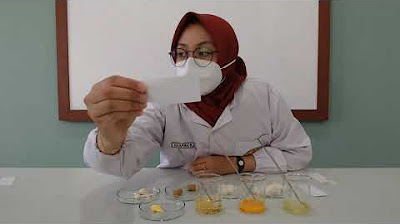Bacteria Sampling
Summary
TLDRThis lab session introduces the testing of milk samples for bacterial contamination, emphasizing essential safety procedures and the use of disposable lab equipment. Participants learn to differentiate between pasteurized and raw milk, highlighting the importance of pasteurization in ensuring safety. The process includes sample collection using 3M Quick Swabs, followed by incubation on Petrifilm Plates to observe bacterial growth. The findings reveal concerning levels of bacteria in pasteurized milk, suggesting potential flaws in the pasteurization process. Overall, the session underscores the critical nature of proper lab practices and the need for effective contamination prevention in food safety.
Takeaways
- 🧪 Always follow basic lab safety procedures, such as wearing gloves and safety glasses, washing hands, and avoiding eating or drinking in the lab.
- 📦 Disposable lab supplies reduce the risk of contamination and save time and money compared to reusable supplies.
- 🧫 Petrifilm plates are advantageous over traditional Petri dishes because they require no preparation, have built-in biochemical confirmation, and occupy less space in the incubator.
- 🥛 Pasteurized milk undergoes a process to kill harmful bacteria, making it safer to consume than raw milk, which may contain pathogens.
- ⚠️ Raw milk can become contaminated during milking, transportation, or storage, posing health risks to consumers.
- 🧼 Proper sanitation practices, including wiping surfaces with a 70% ethanol solution and using a Bunsen burner, are crucial for maintaining a sterile working environment.
- ⏱ Incubation of samples at 90°F (32°C) for 48 hours is essential for allowing bacteria to grow and form visible colonies for accurate evaluation.
- 📈 Estimating bacterial colonies can be done by counting colonies in a sample area and multiplying by the total area, especially when there are too many colonies to count individually.
- 🧪 It's critical to label all samples with the date, source, and initials to maintain accurate records and traceability.
- 🚨 If contamination is found in pasteurized milk, it indicates potential issues in the pasteurization process, necessitating further investigation.
Q & A
What are the basic lab safety procedures that must be followed before testing milk samples?
-Basic lab safety procedures include washing hands before and after handling materials, wearing gloves and safety glasses, avoiding eating or drinking in the lab, securing loose clothing and hair, cleaning equipment after use, and strictly following instructions.
What are disposable lab supplies and why are they preferred?
-Disposable lab supplies are single-use items that reduce the opportunity for contamination compared to reusable supplies. They are also relatively inexpensive and eliminate the need for labor-intensive cleaning, saving time and money.
How does pasteurization help ensure milk safety?
-Pasteurization is a process that uses rapid heat and cooling to kill bacteria and pathogens in milk, significantly reducing the overall number of bacteria present and ensuring the milk is safe to drink.
What types of harmful bacteria can be found in raw milk?
-Harmful bacteria that may be present in raw milk include Salmonella, Escherichia coli O157:H7, Listeria monocytogenes, Staphylococcus aureus, Yersinia enterocolitica, Campylobacter jejuni, Mycobacterium tuberculosis, and Mycobacterium paratuberculosis.
Why is it important to maintain a sterile working environment during the experiment?
-Maintaining a sterile working environment is crucial to prevent contamination of samples, ensuring that the results accurately reflect the presence of bacteria in the milk rather than contamination from external sources.
What role does the incubator play in the bacterial testing process?
-The incubator maintains a suitable temperature of 90°F (32°C), which is ideal for the growth of most bacteria, allowing ample time for microorganisms to grow and form visible colonies.
How are bacterial colonies counted when they are too numerous to count by hand?
-When colonies are too numerous to count, an estimation method is used. This involves counting colonies in a smaller square area of the Petrifilm plate and multiplying that number by the total area of the sample.
What steps should be taken if contamination is suspected in a dairy processing plant?
-Samples should be collected from various areas, such as storage tanks, to pinpoint the source of contamination. Tests should be performed to identify the presence of pathogens like E. coli.
What should be done with disposable equipment after use?
-Disposable equipment should be used according to the manufacturer's instructions and disposed of properly, either in an autoclave or through incineration in microbiology labs or hospitals.
How long can samples remain in storage before testing, and what is the optimal time frame for analysis?
-Samples must be properly stored and analyzed ideally within 24 hours and not later than 48 hours after collection to ensure accurate results.
Outlines

Dieser Bereich ist nur für Premium-Benutzer verfügbar. Bitte führen Sie ein Upgrade durch, um auf diesen Abschnitt zuzugreifen.
Upgrade durchführenMindmap

Dieser Bereich ist nur für Premium-Benutzer verfügbar. Bitte führen Sie ein Upgrade durch, um auf diesen Abschnitt zuzugreifen.
Upgrade durchführenKeywords

Dieser Bereich ist nur für Premium-Benutzer verfügbar. Bitte führen Sie ein Upgrade durch, um auf diesen Abschnitt zuzugreifen.
Upgrade durchführenHighlights

Dieser Bereich ist nur für Premium-Benutzer verfügbar. Bitte führen Sie ein Upgrade durch, um auf diesen Abschnitt zuzugreifen.
Upgrade durchführenTranscripts

Dieser Bereich ist nur für Premium-Benutzer verfügbar. Bitte führen Sie ein Upgrade durch, um auf diesen Abschnitt zuzugreifen.
Upgrade durchführenWeitere ähnliche Videos ansehen

Praktikum Uji Makanan - Bu Shafira Ramadhanty Adityaningsih

Introduction to Water Sampling

Using the Microscope

Microbiology lab equipment | Part 1 of 3 | Basic lab equipment | Basic and general use

Praktikum Kimia Dasar Modul 1. Pengenalan Alat Laboratorium

Pengujian Cemaran Boraks dan Formalin pada Sampel Makanan di Pasar Tradisional Yogyakarta
5.0 / 5 (0 votes)
